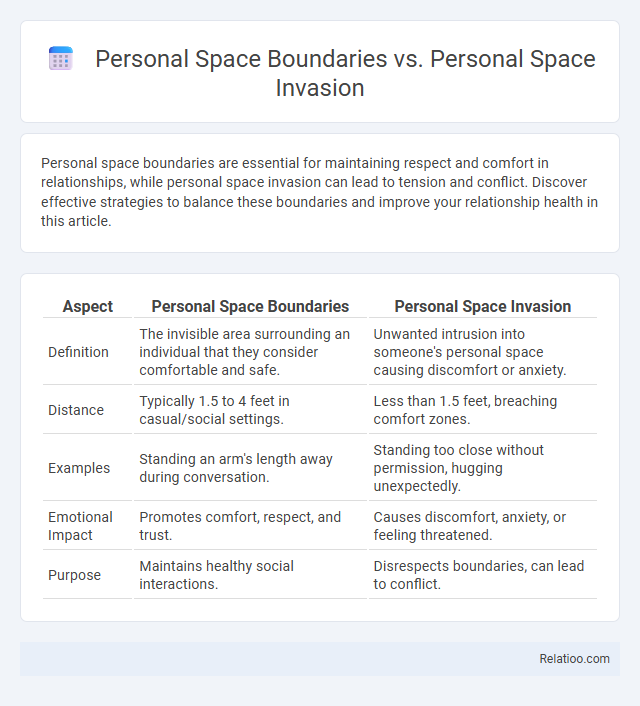Personal space boundaries are essential for maintaining respect and comfort in relationships, while personal space invasion can lead to tension and conflict. Discover effective strategies to balance these boundaries and improve your relationship health in this article.
Table of Comparison
| Aspect | Personal Space Boundaries | Personal Space Invasion |
|---|---|---|
| Definition | The invisible area surrounding an individual that they consider comfortable and safe. | Unwanted intrusion into someone's personal space causing discomfort or anxiety. |
| Distance | Typically 1.5 to 4 feet in casual/social settings. | Less than 1.5 feet, breaching comfort zones. |
| Examples | Standing an arm's length away during conversation. | Standing too close without permission, hugging unexpectedly. |
| Emotional Impact | Promotes comfort, respect, and trust. | Causes discomfort, anxiety, or feeling threatened. |
| Purpose | Maintains healthy social interactions. | Disrespects boundaries, can lead to conflict. |
Understanding Personal Space: Definitions and Importance
Understanding personal space involves recognizing the invisible boundaries individuals set to feel comfortable and secure in social interactions. Personal space boundaries help maintain emotional well-being and respect, while personal space invasion occurs when these limits are crossed without consent, leading to discomfort or anxiety. Your awareness of these distinctions is crucial for fostering respectful communication and preventing unintended invasions.
Types of Personal Space Boundaries
Personal space boundaries vary by culture, context, and individual preference, including intimate, personal, social, and public zones that define acceptable physical proximity. Your awareness of these types helps prevent personal space invasion, which occurs when someone crosses these invisible lines without consent, leading to discomfort or stress. Recognizing the distinctions between personal space boundaries and invasion allows you to respect others' physical comfort and maintain healthy interpersonal interactions.
Cultural Differences in Personal Space Norms
Personal space boundaries vary significantly across cultures, influencing perceptions of personal space invasion and social interactions. In some cultures, close proximity is a sign of trust and warmth, while in others, it can be seen as intrusive or disrespectful, impacting your comfort and social dynamics. Understanding these cultural norms helps navigate personal space appropriately and avoid unintentional invasions.
Signs Your Personal Space is Being Invaded
Recognizing signs your personal space is being invaded includes feeling discomfort, anxiety, or increased heart rate when someone stands too close or touches you without permission. Personal space boundaries define the invisible buffer zone you maintain for comfort, while personal space invasion occurs when these boundaries are crossed without consent, leading to feelings of vulnerability or distress. Your awareness of subtle cues, such as crowding, unsolicited proximity, or persistent intrusion, helps protect your emotional and physical well-being from invasive behavior.
Psychological Effects of Personal Space Invasion
Personal space invasion triggers heightened stress responses and anxiety, often causing discomfort, irritability, and decreased concentration. Psychological effects include feelings of vulnerability, loss of control, and increased aggression due to perceived threats to personal autonomy. Long-term exposure to personal space invasion can lead to chronic stress, decreased self-esteem, and social withdrawal.
Personal Space Boundaries in Relationships
Personal space boundaries in relationships define the physical and emotional distance individuals maintain to feel comfortable and secure, preventing discomfort and conflicts. Respecting these boundaries is crucial for healthy interactions, fostering trust and mutual understanding between partners. Violations of personal space boundaries, often seen as personal space invasion, can lead to feelings of anxiety, resentment, and a breakdown in communication.
Workplace Etiquette: Respecting Personal Space
Personal space boundaries in the workplace define the physical and psychological area employees need to feel comfortable and focused. Respecting these boundaries prevents personal space invasion, which occurs when someone encroaches too closely or intrudes without consent, causing discomfort or stress. Your awareness and adherence to workplace etiquette regarding personal space foster a respectful and productive environment, reducing conflicts and enhancing collaboration.
Strategies to Communicate Your Boundaries
Communicating personal space boundaries effectively involves clear, assertive verbal cues and confident body language to signal comfort zones without ambiguity. Strategies include using "I" statements to express feelings about proximity, setting physical cues like stepping back, and reinforcing limits consistently to prevent personal space invasion. Respecting these communicated boundaries requires recognizing nonverbal signals and responding promptly to any perceived invasion, ensuring mutual respect and psychological safety.
How to Respond to Personal Space Violations
Personal space boundaries define your comfort zone, varying by culture and individual preferences. When facing a personal space invasion or violation, calmly assert your need for distance by using clear, firm language and nonverbal cues like stepping back. Maintaining awareness of your body language and confidently communicating your limits helps protect your personal space and reduce discomfort during interactions.
Fostering Respectful Interactions and Environments
Personal space boundaries are invisible limits individuals set to feel safe and comfortable, which vary culturally and contextually. Personal space invasion occurs when these boundaries are crossed without consent, leading to discomfort or stress, undermining trust in social and professional settings. Fostering respectful interactions requires recognizing and honoring these personal space boundaries to create inclusive environments that promote psychological safety and mutual respect.

Infographic: Personal Space Boundaries vs Personal Space Invasion
 relatioo.com
relatioo.com